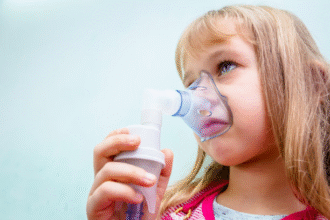Emphysema: Causes, Pathogenesis, Diagnosis, and Management
Emphysema is a progressive chronic obstructive pulmonary disease (COPD) characterized by irreversible destruction of alveolar walls, airspace enlargement, and loss of elastic recoil in the lungs. Patients typically present with breathlessness, chronic cough, and reduced exercise tolerance. Early recognition and comprehensive management are crucial to slow disease progression and improve quality of life.
Epidemiology and Risk Factors
- Prevalence: Emphysema affects millions worldwide, often under the broader COPD diagnosis. Prevalence increases with age and smoking history.
- Primary Risk Factors:
- Tobacco Smoke: Responsible for up to 90% of emphysema cases in developed countries.
- Environmental Pollutants: Long-term exposure to biomass smoke, industrial dust, and air pollution.
- Genetic Predisposition: Alpha-1 antitrypsin (AAT) deficiency accounts for a smaller subset, leading to early-onset panacinar emphysema.
- Other Contributors:
- Recurrent lower respiratory infections
- Occupational exposures (silica, coal dust)
Pathogenesis
Emphysema results from a complex interplay of factors that damage alveolar structures and impair ventilation:
- Protease–Antiprotease Imbalance:
- Smoking and inflammation recruit neutrophils and macrophages, releasing elastase and matrix metalloproteinases (MMPs).
- Oxidative stress inactivates alpha-1 antitrypsin (AAT), reducing protection against proteolytic enzymes.
-
Resulting breakdown of elastin and collagen disrupts alveolar septa and diminishes elastic recoil.
-
Oxidative Stress and Inflammation:
- Reactive oxygen species (ROS) from cigarette smoke and inflammatory cells injure epithelial and endothelial cells.
-
Chronic inflammation perpetuates tissue damage and fibrosis in small airways.
-
Mechanical Factors:
- Airflow limitation and air trapping increase alveolar residual volume, leading to overdistension and rupture of alveolar walls.
Clinical Features
- Dyspnea: Progressive breathlessness, initially on exertion, later at rest.
- Chronic Cough: Often productive when emphysema coexists with chronic bronchitis (overlap COPD).
- Wheezing and Chest Tightness: Due to airway collapse and dynamic hyperinflation.
- Barrel Chest: Increased anterior–posterior diameter due to air trapping.
- Weight Loss: In advanced cases, increased work of breathing leads to muscle wasting.
Diagnosis
- Spirometry:
- FEV1/FVC ratio <0.70 confirms airflow obstruction.
-
Reduced FEV1 correlates with disease severity (GOLD staging).
-
Imaging:
- High-resolution CT (HRCT): Demonstrates areas of low attenuation, bullae, and airway wall thickening.
-
Chest X-ray: May show hyperlucent lung fields and flattened diaphragms.
-
Laboratory Tests:
- Alpha-1 antitrypsin level and phenotype for suspected genetic deficiency.
-
Arterial blood gas analysis in advanced disease to assess gas exchange.
-
Exercise and Functional Tests:
- Six-minute walk test (6MWT) to evaluate functional capacity.
- Pulse oximetry and cardiopulmonary exercise testing if indicated.
Management
Smoking Cessation
The single most effective intervention to slow progression:
– Behavioral counseling and pharmacotherapy (nicotine replacement, varenicline).
Pharmacotherapy
- Bronchodilators:
- Short-acting beta2-agonists (SABAs) for symptom relief.
- Long-acting beta2-agonists (LABAs) and long-acting muscarinic antagonists (LAMAs) for maintenance.
- Inhaled Corticosteroids (ICS):
- Beneficial in patients with frequent exacerbations or elevated blood eosinophils.
- Phosphodiesterase-4 Inhibitors:
- Roflumilast for severe COPD with chronic bronchitis phenotype.
Pulmonary Rehabilitation
- Exercise training, education, and behavior change to improve physical conditioning and self-management.
Oxygen Therapy
- Long-term oxygen therapy for patients with resting hypoxemia (PaO₂ ≤55 mmHg).
Surgical and Interventional Options
- Lung Volume Reduction Surgery (LVRS): Resection of emphysematous tissue to improve mechanics.
- Endobronchial Valves: Minimally invasive option to occlude diseased lobes and reduce hyperinflation.
- Lung Transplantation: Considered in selected patients with advanced disease and poor prognosis.
Prevention and Supportive Measures
- Vaccinations: Annual influenza and pneumococcal vaccines to prevent infections.
- Environmental Control: Avoidance of pollutants and occupational hazards.
- Nutritional Support: Diet counseling to maintain healthy body weight.
- Psychosocial Support: Address anxiety and depression common in COPD.
Prognosis
Emphysema is progressive but highly variable in trajectory. Prognostic factors include:
– Severity of airflow obstruction (FEV1)
– Frequency of exacerbations
– Comorbidities (cardiovascular disease, lung cancer)
Early diagnosis, risk factor modification, and comprehensive management can significantly improve outcomes and quality of life.







